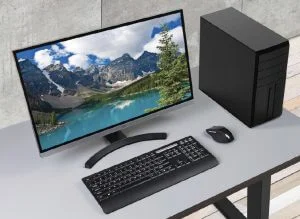 In today’s modern media production environments, you can never have enough displays. And while it does look super cool to put together a system with multiple high-res monitors, doing that can rack up an impressive price tag pretty quickly. Fortunately, electronics manufacturer Monoprice is here to help creators build their multi-display arsenals. Next week. Monoprice will release its Ultra-Slim Aluminum 27″ UHD IPS 4K display:
In today’s modern media production environments, you can never have enough displays. And while it does look super cool to put together a system with multiple high-res monitors, doing that can rack up an impressive price tag pretty quickly. Fortunately, electronics manufacturer Monoprice is here to help creators build their multi-display arsenals. Next week. Monoprice will release its Ultra-Slim Aluminum 27″ UHD IPS 4K display:
The ultra-slim, aluminum bezel houses a Grade A+ IPS glass panel, which is backed by our Pixel Perfect Guarantee. The monitor features two DisplayPort 1.2a inputs, with AMD’s FreeSync technology, and two HDMI® inputs, giving a level of flexibility and connectivity that is unsurpassed.
More details on this Monoprice display:
- Features a maximum resolution of 4K@60Hz
- Adjustable stand can be removed to allow access to the 100×100 VESA mounting points for mounting to a wall or desk mount
- Aluminum bezel houses an Grade A+ IPS glass panel from LG
- Features two DisplayPort 1.2a inputs, with AMD’s FreeSync technology, and two HDMI® inputs
- Features ultra-wide 178° horizontal and vertical viewing angles
- Display ships with stand neck, stand bases, M4x10 Screws (x3), M4x6 Screws (x3),
HDMI cable, AC power adapter, AC power cord, and user’s manual
Monoprice hasn’t stated an exact date for when these displays will be available for purchase. But a recent e-mail sent by the company stated that they’d be on the market “next week.” The Monoprice Ultra-Slim Aluminum 27″ UHD IPS 4K display will have a retail price of $399.

 4K video streaming is definitely here to stay. In fact, 4K streaming is becoming so commonplace, it’s even possible to now stream live 4K video from space. That’s exactly what NASA is going to do during the 2017 NAB show, happening later this month in Las Vegas. NAB recently announced via mass e-mail that the space-vid stream will occur during a panel called
4K video streaming is definitely here to stay. In fact, 4K streaming is becoming so commonplace, it’s even possible to now stream live 4K video from space. That’s exactly what NASA is going to do during the 2017 NAB show, happening later this month in Las Vegas. NAB recently announced via mass e-mail that the space-vid stream will occur during a panel called  Time waits for no one. Nor does the inevitable progress of higher-resolution video. It still feels like true HD video has just barely been normalized here in the United States. And yet the push beyond HD, into 4K and even 8K, has begun. The latest example of the move forward comes from Japanese public broadcasting agency NHK (also known as Japan Broadcasting Corp.) as the company has begun
Time waits for no one. Nor does the inevitable progress of higher-resolution video. It still feels like true HD video has just barely been normalized here in the United States. And yet the push beyond HD, into 4K and even 8K, has begun. The latest example of the move forward comes from Japanese public broadcasting agency NHK (also known as Japan Broadcasting Corp.) as the company has begun  Fujinon is a well respected manufacturer of camera lenses. Fujinon was recently tied more heavily to its parent company, Fuji Film. It’s a small change in name only. The Fuji folks are still hard at work creating new top of the line products.
Fujinon is a well respected manufacturer of camera lenses. Fujinon was recently tied more heavily to its parent company, Fuji Film. It’s a small change in name only. The Fuji folks are still hard at work creating new top of the line products. 4K video is old news to media professionals. And even tho there have been plenty of products built from the group up with 4K in mind, there are still a lot of legacy manufacturers that need to catch up. Nvidia is a leader in the video processing world. And while they’ve offered some 4K products already, the company believes they still have some improvements to make in how their products handle ultra HD signals.
4K video is old news to media professionals. And even tho there have been plenty of products built from the group up with 4K in mind, there are still a lot of legacy manufacturers that need to catch up. Nvidia is a leader in the video processing world. And while they’ve offered some 4K products already, the company believes they still have some improvements to make in how their products handle ultra HD signals.